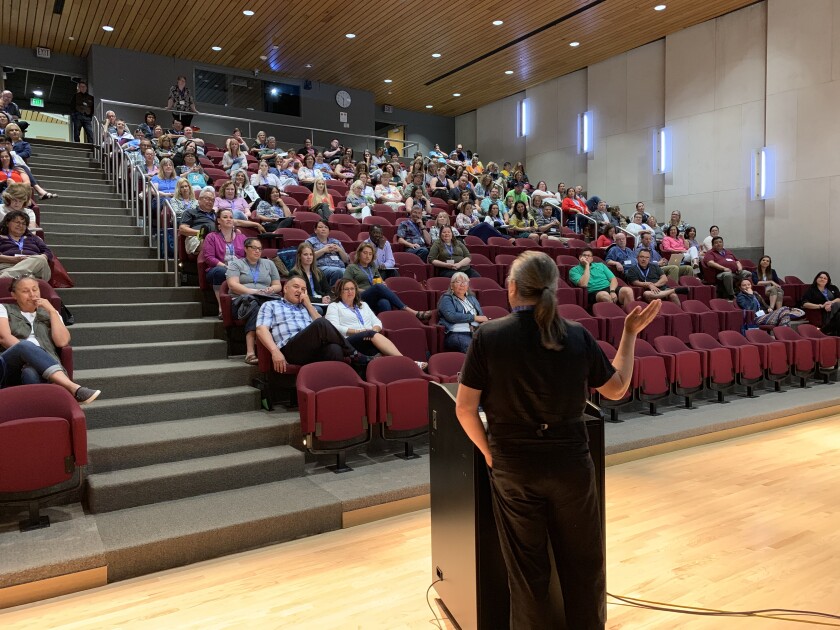MOORHEAD — Kay was in shock when she first started attending school off the White Earth Reservation.
“I felt intimidated at first,” the 17-year-old said, adding that she was “just trying to get into the habit of not being around so many Native or Ojibwe people.”
Kay attended school on White Earth until middle school, when her grandmother — her primary caretaker — died. She went into foster care and recently moved to Moorhead High for her senior year. (Kay, whose name has been changed, is a minor and a part of the foster care system. Her foster parents and social worker requested her name and identity not be revealed.)
Now at Moorhead, Kay is one of 530 Native American students out of about 7,000 students in the Moorhead school district. She said most of the friends she has made are Ojibwe, and one of them is from White Earth, too. She enrolled in a Spanish class at the beginning of the semester but quickly dropped out.
“I wish they offered classes about the Ojibwe language,” she said.
ADVERTISEMENT
Kay struggles to embrace her Ojibwe identity in school because she’s “too scared of being judged.” Her U.S. history class is an especially difficult room. She’s the only Native American in the class, and she said it’s taught from the European perspective.
“I have to hold my tongue because I’m not going to be the one to speak on what is the actual history,” she said. “I would be afraid of everybody turning against me.”
Kay’s foster father, Dan Bonner, said, “There just needs to be a factual, culturally sensitive narration of American history that doesn’t revolve solely around the European history and the colonization of America.”
Bonner, a member of the Roseau River Tribe in Manitoba, Canada, serves as the chair of the Moorhead Public Schools Native American Parents Committee. His wife, Fauntel Deshayes, serves as the committee secretary. The couple has two biological children as well, one in elementary and one in middle school.
All in all, Deshayes said public schools are making strides in incorporating more of the Native American perspective. But the big issue is that the history books are “completely wrong,” she said.
On a Monday night in November, Deshayes and Bonner sat at a conference table with a dozen other parents and educators in the boardroom at the Probstfield Center for Education for the monthly Native American parent committee meeting.
They discussed plans for a Native American ribbon skirt- and shirt-making project with the students and filled out individual needs assessments for their kids. Indian Education liaison Delores Gabbard led a presentation on her time at the National Indian Education Association convention in Washington, D.C.
ADVERTISEMENT

In an interview, Gabbard said she’d like to see more of the Native American perspective “embedded” in the curriculum. “Not just something we do on the side,” she said.
As for students feeling comfortable expressing their Native American identities, she said: “It’s coming. I see that change now happening.
“For my kids, I always encourage them to teach about their culture,” she said. “They’ve done a pretty good job of doing that, and it’s always been well-received.”
Kristy Page, a psychologist for Grand Forks Public Schools and a member of the Turtle Mountain Band of Chippewa, said Native American students’ experiences often vary based on whether they’re coming from a reservation school or grew up off a reservation.
“You can have Native Americans who have grown up in Grand Forks the whole time and (they will) not feel any different,” she said. “From the reservation, they can feel a difference because they can see a difference culturally.”
Sonya Anderson, the chair of the Native American Parents Committee for Grand Forks Public Schools, said the group is dedicated to helping educate Indigenous students on their cultures.
“Educate them about it, and help our students feel like they belong,” she said, adding “it’s OK to celebrate their culture.”
ADVERTISEMENT
Lucy Fredericks, the director of Indian and multicultural education at the North Dakota Department of Public Instruction, works to help educators and students better understand Native American Cultures.
A member of the Standing Rock Sioux Tribe, Fredericks joined the department seven years ago. Since then, the department facilitated the annual Indian Education Summit , a conference now in its sixth year that teaches educators more about Native American culture and learning styles.

The department also has been working to roll out the North Dakota Native American Essential Understandings — a compilation of ideas and traditions valued by Indigenous elders in North Dakota.
The project started in the concept phase in 2015 and is now in the implementation phase, Fredericks said, adding that educators can incorporate essential understandings — like humor, generosity and storytelling — in their lesson plans.
Though there’s a gap between graduation rates for Native and non-Native students, Fredericks said that gap has been closing. In the past seven years, the graduation rate for North Dakota’s Indigenous students — which make up 9% of the state’s student population — has increased from 57% to 72%. That's well below state's overall graduation rate of 88%, but the rise is promising.
Fredericks said it’s all about helping Indigenous students to “feel more comfortable, to want to be in school, to want to learn.”
ADVERTISEMENT









